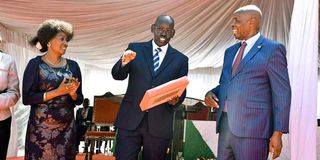Equity among all schools can bring fair competition

Basic Education Principal Secretary Belio Kipsang (centre) holds up copies of the 2022 Kenya Certificate of Secondary Education (KCSE) exam results released on January 20, 2023, at Mitihani House. With him are Education Cabinet Secretary Ezekiel Machogu (right) and Teachers Service Commission (TSC) CEO Dr Nancy Macharia.
Celebrations seem to have hit fever pitch as questions abound as to how newbies managed to topple ‘academic giants’ to post the most coveted results in the 2022 KCSE exam.
Amid the fete, the conversation should be broached on how to rescue the miniature schools with perennially dismal performance.
Even when there seems to have rained heavenly manna in the form of quality grades, with most schools posting humongous positive deviations, the academic underdogs have nothing to show for it.
As the giants tally the number of quality grades and are upbeat about a tsunami of grade A, the little fellows are puzzled by the jinx of grade E, casting a spell on their future, academically.
To reduce the bottom grades, the government must invest in elevating the sorry state of many schools. The dinosaur kind of results in the national exams is preposterous but evitable.
Disparities
Agenda 4 of the Sustainable Development Goals stipulates the need for inclusive equitable quality education and the promotion of lifelong learning opportunities. My expectation of education, especially in public schools, is to be a unifier. Sadly, therein matters of class and mind-boggling social stratification thrive. A few crucial areas create a disparity between the top schools and those in the lower cadre, determinants in the quality of learning.
In the top schools, facilities are bountiful. Some have multiple well-equipped laboratories with lab technicians as most of their humble counterparts have none. A requisition for lab equipment would take months before delivery. Congested classrooms and limited textbooks and crucial revision materials also characterise the beggarly schools. High student-teacher ratios hamper seamless learning.
Teacher motivation is of utmost significance for performance. Heightened interpersonal relationships boost morale. That remains a preserve of the well-to-do schools. Herein, teachers are taken for self-care trips and productivity management workshops, where they learn trends in classroom management. Across the road, teachers are always wishing for a transfer, and the only motivating factor is their salary. That hampers creativity in content delivery.
In the ‘A’ schools, learners’ welfare is significantly upheld. Mental and emotional wellness is checked through motivational talks by professional counsellors. Learners are accorded broad access to information on career choice, time management and crucial self-organisation skills. The schools have the wherewithal to serve learners a three-course meal. With both physical and psychological needs adequately met, the learner has ample time for studies.
But their counterparts are battling a myriad of issues. Some, in day schools, go days without a decent meal due to the necessitous circumstances at home. Others juggle school and parenting.
Education will be best celebrated when the country achieves some balance and accords a fairground to the schoolchildren. This is attainable through the mobilisation of an Education Equalisation Fund to elevate the standards of the needy schools to better compete with their affluent counterparts.
Mr Gisemba is a high school teacher, author and editor. [email protected].





